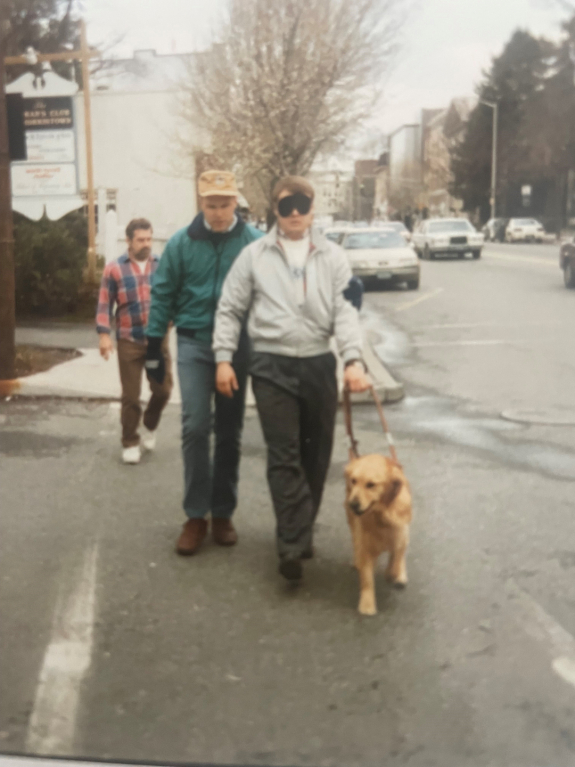NDVS/SB Superintendent
Runner, O&M Specialist, Staff Cheerleader
Superintendents have a long to-do list each day. They deal with budgets, schedules, and staff conflicts. They answer to stakeholders, including parents, families, and legislators. If staff members are out, they may find themselves teaching, driving bus, or serving lunch. But perhaps the most important task, at least for NDVS/SB Superintendent Paul Olson, is staff cheerleader. “I have had the pleasure of getting to know people at many specialized schools for the blind and amazing teachers of the visually impaired in public schools across the country,” Paul says. “I firmly believe we have the most dedicated and talented staff. We are a little stretched at times, but the NDVS/SB staff do an amazing job for our citizens. They are top notch.”
This is a typical quote from Paul as it shifts the focus off of him and gives all credit and accolades to his staff. But behind every great employee is a great boss. The Chinese philosopher Lao Tzu said, “The wicked leader is he who the people despise. The good leader is he who the people revere. The great leader is he who the people say, ‘We did it ourselves.’” Staff have spoken and Paul is, indeed, a great leader. Find out why by reading below.
What is your role at NDVS/SB?
I have been superintendent since August of 2013. Prior to that I taught orientation and mobility to students and adults across the state. 
How did you end up in the world of vision?
I first worked as a paraprofessional at ND School for the Blind after college with no plans to stay. I observed an Orientation and Mobility Specialist working with a student in our hallways and was intrigued. This instructor was Tori McCallmun (now Tori Johnsen) who was then working for GF Public Schools. She inspired me and encouraged me to pursue this training.
How has the world of vision changed since you started working?
The proliferation of technology is apparent. I started using an Apple IIe on my desk to write reports back in 1991, and I thought it was pretty cool. The technology that our students and adult clients have available to them has exploded. One thing that has not changed, however, is the fact that the white cane and braille are still two of the most practical tools that lead to independence.
How has NDVS/SB changed over the years?
I was here in the Spring of 1995 when all of the students that had been residential for 9 months out of the year transitioned back to their home schools and sometimes group homes. I am very grateful for having been here during that time. For some students it was the best environment for learning. That said, those of us who remained at NDVS/SB had to fully embrace doing outreach across the state and building a successful model of providing short-term program weeks for students. We were the first in the nation to do this. We were modeled after a program in Nova Scotia.
How do you see NDVS/SB evolving in the future?
We have been continually maintaining and improving our headquarters in Grand Forks. I believe that this setting will remain a state-of-the-art facility to serve people of all ages for the next 30-40 years. Besides that assumption, I foresee that the nature of what we provide across the state and at our center-based training center in Grand Forks will continue to adapt to meet new needs. We will be successful if we evaluate and change as people’s needs change from year to year. It is a fast-changing world.
When you were an O&M Specialist, what was your favorite lesson to teach?
Perhaps what I found most rewarding was when a student gained proficiency with the cane so that basic protection was afforded, but I think I most enjoyed when the student (of any age) had built a mental map of their neighborhood or town and could plan and walk routes to locations of interest or need. Destinations like a friend’s home, a convenience store, their bank, a restaurant. When they had built such a strong sense of orientation that they could even apply it in unfamiliar locations. So, in a nutshell I enjoyed the lesson that built a strong sense of orientation and problem solving.
Is there anything you think people would be surprised to learn about NDVS/SB?
I really enjoyed working for my first boss Michael Graham who was blind. He was an amazing traveler and really opened my eyes to how independent people with blindness could truly be. Ironically there were some who thought he had poor mobility skills because he moved quickly and would sometimes bump into people. I, however, saw one of the most skilled travelers in the big world that I had ever seen and I do not know if I have seen more than a couple people since that rivaled his skill level. He also was one to advocate unapologetically when services needed to improve. He did this at his own peril, and he left ND after a couple years. I have tried to emulate his willingness to advocate when something needs to change. Fortunately, that has not resulted in me needing to work elsewhere – yet!
What do you like to do for fun?
I like to run…can’t figure out why I get slower every year though. It can’t be my age, right?
